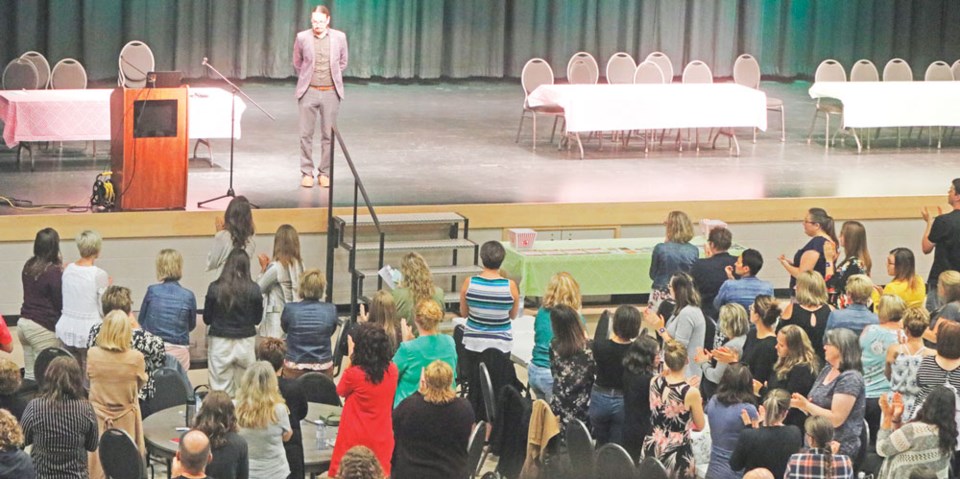Teachers in the South East Cornerstone Public School Division were urged to continue the spirit of reconciliation in their classrooms in the coming school year, as a First Nations speaker, Kevin Lamoureux, addressed them at their convention on Thursday at the Cugnet Centre in Weyburn.
Lamoureux, who is from the University of Winnipeg, was the keynote speaker to the South East Cornerstone Teachers Association as they gathered from around the school division for professional development sessions in preparation for the new school year.
He told the teachers that the day the final report was issued by Canada’s Truth and Reconciliation Commission in Ottawa in June was “the best day of my life,” as the report laid out 94 calls to action to help First Nations people in Canada to be reconciled with the injustices and wrongs of the past.
He happened to be in Ottawa to hear that report in person, and said, “I had this feeling come over me that my grandparents were there with me … it was one of the best days of my life. It was an incredible feeling. What we were given that day was a gift.”
The audience, which included all teachers from Cornerstone along with administrators and the Cornerstone board of trustees, was urged to read through the calls to action by the committee.
Lamoureux said if they do, they should keep two questions in their mind with each recommendation: why is this being asked of us? and what can we do about it?
Before diving into the issues around why the Truth and Reconciliation Commission was formed, he said he wanted everyone to know and realize they were not the ones who created the situations that Canada’s Indigenous peoples are dealing with now, and it’s not their fault.
He pointed to the federal Indian Act as a major source of the inequities and injustices that have been done to First Nations people, and illustrated it with the story behind Jordan’s Principles.
This principle was named for an aboriginal youth named Jordan from Norway House in Manitoba. He became very sick and had to be airlifted to Winnipeg for medical treatment, and eventually he got better.
The problem arose that because he was Indigenous, no level of government would pay for him to be flown home, and he languished in a hospital bed for five years while the arguing went on.
“He died, never getting to leave the hospital. When he passed away, the governments looked into this with shame, and they decided, if you can send a child home, send him home, and worry about paying for it later. That’s Jordan’s Principle,” said Lamoureux, adding this only occurred because the child was Indigenous.
No other child would have been left there in that hospital bed, he said, and this was entirely due to the Indian Act which lays out what can or cannot be paid for by the government.
Lamoureux also noted that the Indian Act is under federal jurisdiction and in spite of repeated calls by First Nations leaders to change or eradicate it, the government never has.
“Our federal government has failed to live up to this on every single opportunity they’ve had. They spend more money litigating First Nations people than any other government or group,” said Lamoureux, adding of the Indian Act, “It’s a piece of legislation that dictates every aspect of life for aboriginal people, including who is and is not an Indian. It dictates health care, which is why Jordan lay in that hospital for five years.”
The part where educators come in, he said, is to teach about what really happened to students. At the university where he works, where 88 per cent of the students are non-aboriginal, he was asked a lot of tough questions about the issues around reconciliation, and a comment he heard repeatedly was, “‘Why is this the first time I’m hearing about this?’ I had students break down in my office as we talked about this.”
One of the impacts of the Indian Act is that schools do not get the level of support that students in the public school system get, as Lamoureux pointed out that schools get $2,000-$4,000 less per year per student.
“There’s nothing in the Indian Act that talks about teaching days or school equipment,” he said, adding this act also led to the residential school system, which saw 150,000 First Nations children taken away from their families to be educated.
Reconciliation is a concept that is not subject-specific, he said, pointing out that any teacher in any subject can build in concepts like safety of identity to be who they are, whether that’s as an aboriginal person or any other cultural identity.
He learned a concept from an Ojibway teacher that could be used, where the question can be asked, “Are you living in a good way? Are you living up to your full potential as a human being? Schools can be a place where we practice this.”



